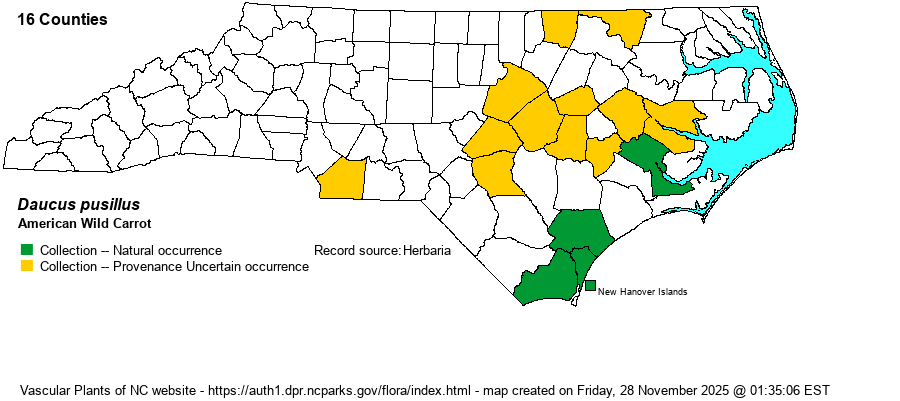| Author | Michaux | |
| Distribution | Scattered over parts of the Coastal Plain, but most prevalent in the central portions, for some odd reason -- as opposed to expected collections from many more southerly counties, including the Sandhills. A few records for the eastern and southern Piedmont. There is a possibility that this species is not native as far north as NC, as the distribution of records (as mentioned above) is anomalous, and nearly all collections are in weedy places and/or in counties without natural sandy soil habitats, as opposed to more obvious sandhills counties from Moore and Richmond southeast to Columbus and Bladen counties. For now, based on the range map in Rodgers (1950), the website editors are considering records from 4 southeastern counties as "natural occurrence" and all others as "uncertain provenance". Rodgers' monograph (1950) states that D. pusillus is native in NC, while at the same time describing its habitats as "waste areas."
This is a Southern species, ranging barely to southeastern VA (where considered non-native), and south to central FL, and west to CA and B.C.. It also ranges north into central TN and to MO. The map in Rodgers (1950), based on specimens from 12 herbaria, show records from only 4 counties in NC, 11 SC, 4 GA, 9 FL, 1 AL, 2 MS, and 1 TN. In 2021, NC has records from 16 counties, the plant atlas of Alabama maps it in 30 counties, while the plant atlas of Florida maps it in 20 -- these suggest the greatly increased spread of an alien rather than new finds of a native plant. D. pusillus is also documented as native and widespread in Argentina, southern Brazil, Chile, and Uruguay (Catalogue of the Vascular Flora of the Southern Cone, 2008). This begs the questions: is it truly native in both areas? Is it native only in South America and alien here in the U.S.? In fact, Weakley (2024) now maps it as Provenance Uncertain in all Southeastern states and regions, saying "There is perhaps doubt that this species is native in North America, at all."
| |
| Abundance | Strongly declining, as the latest SERNEC record with a date is 1967; most records are from the 1950s. Hardly anyone seems to have seen it in recent decades, and it is clearly rare today. In fall 2024, the NCNHP took the website editors' suggestion to add the species to its Watch List as W5 (Rare owing to a Severe Decline to Population or Habitat). There are three Research Grade photo on iNaturalist -- from Wayne County, in 2020, and from Wake County in 2023 and 2024. Habitat does not seem to be limiting, but the populations have crashed, for unknown reasons. | |
| Habitat | This is a ruderal species of roadsides, fields, pastures, and waste places. Most sites are in sandy soil, yet no specimen label indicates its presence in natural sandhills habitats. | |
| Phenology | Blooms in April and May, and fruits in May and June. | |
| Identification | This is a rather slender species that might be passed over as a smaller version of the abundant exotic Queen-Anne's-lace (D. carota). It grows to about 1.5-2 feet tall, usually unbranched. The scattered stem leaves -- about 4 inches long -- are generally ovate in shape, highly dissected twice, into lacy, fern-like segments, with the smallest segments barely 1/10-inch wide. The terminal umbel, and any side umbels, are flat-topped, with numerous rays, creating an umbel only about 2-2.5 inches across, noticeably smaller than that of D. carota, which has umbels about 4-5 inches across and often domed. Also, photos show large leaf-like bracts extending beyond the umbel. In the exotic species, the central flower in each umbel may be dark red to maroon, whereas as in the native species this flower and all others are white. (Some populations of D. carota lack such maroon central flowers, so absence of such flowers is not a useful character.) Also, the longest rays in an umbel in the exotic species are generally more than 3 cm long, whereas D. pusillus has rays shorter than 3 cm. No large bracts appear below the umbel. The most distinctive feature is the fruit -- this species has long barbs/spines, and thus the inflorescence at that season looks like it contains many small "cockleburs"; the abundant D. carota in fruit has the involucral bracts not obviously spiny. It is not clear if biologists 1) are searching but simply are no longer finding much of this species in recent decades, 2) are finding it in numbers but not collecting it anymore, or 3) are simply not paying attention to any Daucus for the reason that it is probably "just" the exotic species. | |
| Taxonomic Comments | None
| |
| Other Common Name(s) | Rattlesnake-weed | |
| State Rank | S1S2 | |
| Global Rank | G5 | |
| State Status | W5 | |
| US Status | | |
| USACE-agcp | | |
| USACE-emp | | |

